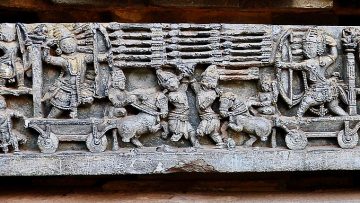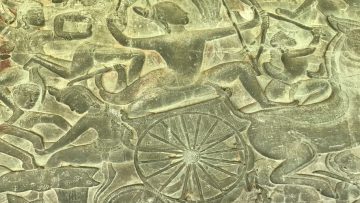A quintessential South Indian (or may be all Indians) knows and values the immense civilisational contribution of the entertainment industry. As a Telugu born woman, watching a white and black pauranika film with family even if for the hundredth time and follow it up with animated discussions is a part and parcel of domestic life. And these watching sessions would be followed by deep discussions into source literature, classical literature, commentaries, pravachanas as per the exposure and immersion that each of us experienced. That is a typical dinner table discussion between me and my parents. They were naturally excited when I told them about this new series on 18 Shakti Peethas. In an era where the extreme capitalist tendency of OTTs declares ‘sleep’ and ‘family time’ as their competitors, it is hard to find Indian content where a whole family can watch together without cringe moments or violence or violation of family values every 10-15 minutes. In the era where darkness of a plot is celebrated as art, Sarvam Shakthimayam was a breath of fresh air that reminded me of the line from Lalita sahasranama – Daurbhaagyatoolavaatoolaajaraa-dhvaanta-raviprabhaa – She is The Wind that uproots the tree of poverty (of thought) and the Sun that brightens the darkness of ageing (rotting of art).
Written by BVS Ravi and directed by Pradeep Maddali, this 10-episode series takes the viewer on an engaging journey through the 18 Shakti Peethas, in the country including the two outside the current political borders Shaankaripeetha of Lanka and Shaaradapeetha in current PoK. The drama starts with a distressed businessman Madhav Suri (essayed by Sanjay Suri) struggling to maintain his financial stability which in time would have alienated him from his wife (Priyamani) and two children (Abhay Simha Reddy and Aslesha Thakur) . They embark on a 40-day long journey to cover the 18 Shakti Peethas, the 18 shrines of Devi Sati. They are also joined by an atheist writer Ranjith (Sameer Soni) in their journey. The casting is convincing in their delivery and before we know, the audience feels connected to the characters and their challenges.
The story starts with dissonance at its highest among the lead characters where each cannot bear the sight of the other, a family battered by the consuming dynamics of Artha-Kama finally (and grudgingly) taking refuge in Dharma, in this case, represented by the Supreme Feminine. They don’t just visit the Kshetras but also interact with local people seeped into the spiritual experience to whom knowledge of the Divine coexists alongside their day-to-day mundane life. It was these interactions with common folks, be it the businessman at Alampur, the priest at Pithapuram or even the hotel boy at Srisailam explaining intricacies of various practices in their own simple terms, thus presenting a new outlook of life that added a unique ring to the whole series. Perhaps this is the underlying message of Sarvam Shaktimayam, the Supreme Shakti guides her distressed children through their path of progression through these soulful interactions and meaningful messages from all directions. Right from an Aghori to an erudite Pandit to an innocent local labourer or a remote tribal citizen, the knowledge of divinity is all pervading and that is what seems like the writer/director’s attempt to portray. Each episode has a character or two pondering over a specific issue, assisted by the spiritual titbits from the Kshetras covered there.
When the atheist writer Ranjith Suri questions the concept of ‘caste/community wise free meal system’ at Srisailam, the hotel peon innocently yet poignantly tells him to think from the perspective of the donors who sponsor these schemes and the varied practices that get supported and organised. The simple message is strongly rooted in practicality of ground action of annadaana, an exalted practice that exists among devout Hindus.
Each character goes through their trial by fire, faces questions that would have deeply troubled them and finds their own rafts to sail through the turbulent waters around them. The journeys are common as well as personal, all under the compassionate drishti of the Supreme Mother. She watches them all along, letting them make their own choices, undertake their own journeys, diverge and reconverge as each of them carve out a pathway of their own. The show attains the new rhythm and momentum post Kashi episode which in my view presents the crescendo of conflict where Pranav, the son of lead character encounters an Aghori and the ensuing conversation elevates the viewer to higher planes of enquiry, deeper within our own selves.
Another beautiful aspect of the series is that it focuses on an organic, gradual and conscious transformation among the lead characters rather than forcing a formulaic and miraculous Happily Ever After. Finally, as the family reconciles and reunites, richer with their own lessons and insights, forgiving their own selves and others, one can see the soulful craft of the director. Madhav and Priya’s marriage troubles being the main thread of the plot, one expects a miracle at their time at Kamakhya peetha itself where the couple performs the Rajashyamala homam. Srividya Upasakas would be aware that Goddess Rajashyamala ensures balance and harmony. To the viewers’ surprise, the conflict only escalates after the homam and the couple part ways mid journey. The grace of the Goddess though has its uncanny way of galvanising their transformation and the reunion happens at Chamundeshwari hills Mysuru, the place where Mahishasura, the ego personified was subdued by Devi Chamundi. The reunion happens as the couple gives up their egos after going through their own due process of self-enquiry. Giving up ego was the key action, probably propelled by the Rajashyamala Homam – the effect is not an unrealistic miraculously instant but gradual and organic.
The series would enthuse one to wish to undertake a similar journey. The idea of covering 18 Shaktipeethas within the same tour is indeed exhilarating. We are left praying for Mother Sharada to manifest again at Kashmir, Maa Shrinkhala to find her own way to give Her Darshan at Ponda, reminding us of the painful points the only living civilisation that worships the Feminine had to see in its distant and not so distant past. Even as Madhav Suri offers the soil he would have devotedly collected in all the 18 kshetras to the sea, signalling a surrender of everything discreet and personal to the all-encompassing Divine, it is a fine reminder to the viewers to continue on our own spiritual journeys and stay open to small experiences that hold big lessons as Divinity is omnipresent.
The transformation of the rationalist writer Ranjith could have been given a little more space. The parallel conversation he has with an atomic scientist and Madhav has with a saadhaka at Kamakhya was well crafted but leaves one wanting for more in depth interaction. The only aspect of this wonderful series that is dissonant is the ending part of the Title track where beejaksharas of Devi Moolamantra are uttered in a totally inappropriate husky whispering that does not go well with the rest of the impressive writing and cinematography.
Sarvam Shakthimayam is a great watch whether you are watching it by yourself or with family. Perhaps the Shakti will have Her own way of awakening the seed of Jignyasa within each of us that propel us towards carving our own unique journeys towards a common civilisational goal. Srimatrenamah.
Note: The series ‘Sarvam Shakthimayam’ is currently streaming on ZEE5.
Feature Image Credit: zee5.com
Disclaimer: The opinions expressed in this article belong to the author. Indic Today is neither responsible nor liable for the accuracy, completeness, suitability, or validity of any information in the article.











